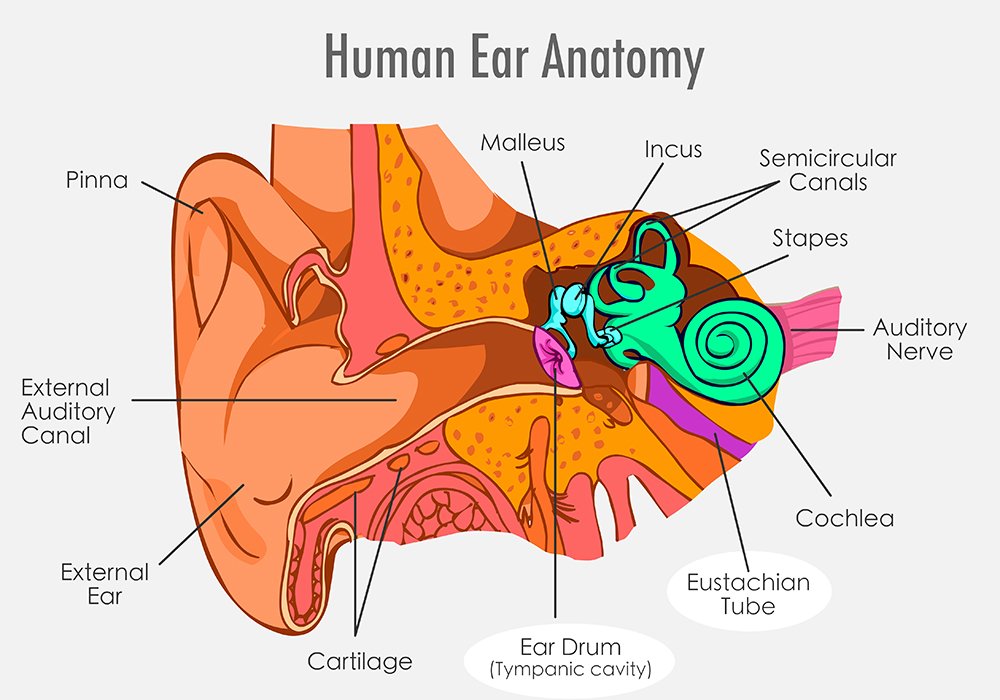The Ears Have It
It happens to just about every child under the age of three. It’s the single most common reason children visit their healthcare providers. What is it? The dreaded ear infection. Five out of six children have at least one ear infection before they turn three.The ear has three main parts: outer ear, middle ear and inner ear. Ear infections occur in the middle ear, behind the eardrum. The eustachian tube connects the back of your throat to the middle ear. This tube allows your middle ear to drain any infection. Children are especially prone to ear infections because the tube from the ear to the throat is more flat and narrow, not slanted downward (as it is shown in the diagram)The infection usually starts with the child having a cold, allergies or other upper respiratory infection. The infection causes congestion, runny noses and other drainage. That congestion causes the nasal passages, throat and the eustachian tubes to swell. When the tubes swell, they become blocked and the fluid that would normally drain out is now clogged behind the eardrum. The fluid puts pressure on the eardrum which causes pain and often affects hearing.Parents usually notice their young child tugging at their ear at the first signs of an ear infection. They may become fussy or clingy. You may notice that they are crying frequently and are unable to let you know what’s wrong. Children also have trouble sleeping if they are laying down due to the pressure on their eardrum, you might find yourself sleeping with them in a comfortable chair so they are propped up.Ear infections may clear up on their own but you need to take your child to their healthcare provider if you notice any of the following:
The eustachian tube connects the back of your throat to the middle ear. This tube allows your middle ear to drain any infection. Children are especially prone to ear infections because the tube from the ear to the throat is more flat and narrow, not slanted downward (as it is shown in the diagram)The infection usually starts with the child having a cold, allergies or other upper respiratory infection. The infection causes congestion, runny noses and other drainage. That congestion causes the nasal passages, throat and the eustachian tubes to swell. When the tubes swell, they become blocked and the fluid that would normally drain out is now clogged behind the eardrum. The fluid puts pressure on the eardrum which causes pain and often affects hearing.Parents usually notice their young child tugging at their ear at the first signs of an ear infection. They may become fussy or clingy. You may notice that they are crying frequently and are unable to let you know what’s wrong. Children also have trouble sleeping if they are laying down due to the pressure on their eardrum, you might find yourself sleeping with them in a comfortable chair so they are propped up.Ear infections may clear up on their own but you need to take your child to their healthcare provider if you notice any of the following:
- Your child is younger than 3 months and shows a fever of 100.4 F or more
- A fever above 104 F for any child at any time
- The fever lasts more than a day in a toddler younger than 2
- The fever lasts more than 3 days in a child age 2 and older
- Your child seems to be in strong pain.
- If you see drainage coming out of the ear.
The treatment for ear infections can vary because many times the source is viral. That means that the cold is a virus which does not respond to antibiotics. Instead your healthcare provider will treat the symptoms by recommending a pain reliever and giving you tips on how to keep your child comfortable. If your provider determines that the infection is based on a bacteria, they may prescribe antibiotics.You can prevent ear infections with a few simple steps:
- When giving the bottle to infants and toddlers, make sure they don’t lay down flat to drink. Have them sit up or hold them in a more upright position. This will allow the eustachian tubes to drain.
- Wash their hands (and yours) frequently to avoid spreading germs.
- Avoid exposing your child to excess pollution or tobacco smoke.
- Be sure your child is up to date on immunizations. There is some evidence that vaccines can help prevent ear infections.
Ear infections are very much part of almost every child’s life. Ear infections are mostly due to your child’s anatomy, their eustachian tubes still need to grow to allow them to drain properly. Over time, most children experience fewer ear aches as they get older. But if you have any medical concerns about your child’s health or development, contact your healthcare provider. Remember that KanCare coverage can give you peace of mind when it comes to taking care of your child's health needs.
